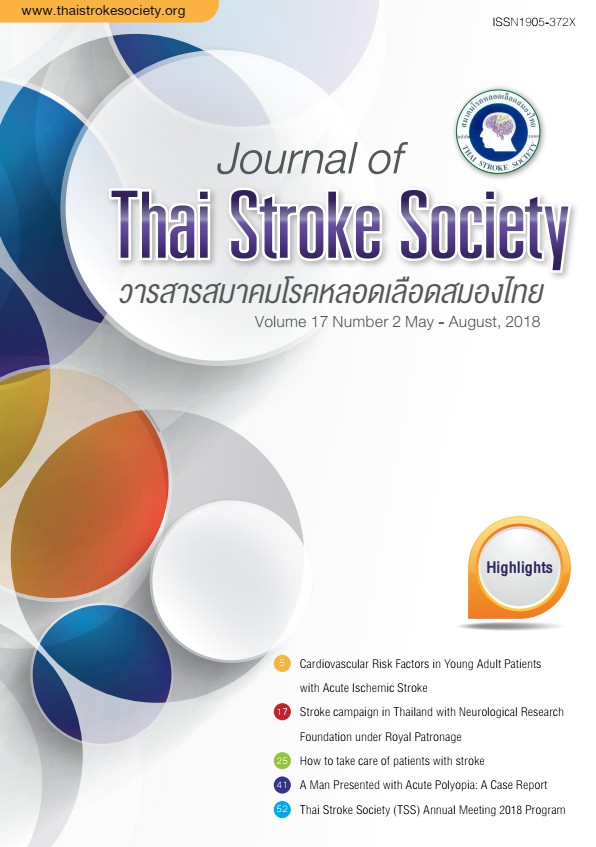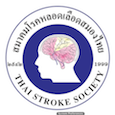A Man Presented with Acute Polyopia: A Case Report
Abstract
A 52-year-old Thai male presented with acute onset of seeing multiple images when focusing on one object or polyopia. The symptom persisted even though he closed one of his eyes. The neurological examination revealed normal extraocular movement and visual field. His magnetic resonance imaging (MRI brain) showed acute tiny infarction at left occipital cortex. There was no large vessel occlusion from vascular imaging study. Holter monitoring revealed normal sinus rhythm without detectable arrhythmia. Agitated saline with TCD/TTE/TEE showed large shunt-size patent foramen ovale without atrial septal aneurysm. The diagnosis of acute ischemic stroke due to cardioembolism from patent foramen ovale was made. In summary, the thorough history taking together with appropriate investigation could help diagnose the uncommon cause of stroke, which lead to proper treatment.
References
Bender MB. Polyopia and monocular diplopia of cerebral origin. Arch Neurol Psychiatry 1945;54:323-38.
Cornblath WT, Butter CM, Barnes LL, et al. Spatial characteristics of cerebral polyopia: a case study. Vision Res 1998;38:3965-78.
Alsheikh-Ali AA, Thaler DE, Kent DM. Patent foramen ovale in cryptogenic stroke: incidental or pathogenic? Stroke 2009;40: 2349-55.
Bang OY, Lee MJ, Ryoo S, et al. Patent Foramen Ovale and Stroke-Current Status. J Stroke 2015;17:229-37.
Thaler DE, Ruthazer R, Di Angelantonio E, et al. Neuroimaging Findings in Cryptogenic Stroke Patients With and Without Patent Foramen Ovale. Stroke 2013;44:675-80.
Kim BJ, Sohn H, Sun BJ, et al. Imaging characteristics of ischemic strokes related to patent foramen ovale. Stroke 2013;44:3350-6.
Tsivgoulis G, Sharma VK, Alexandrov AV. Detection of Right-to-Left Shunt With Transcranial Doppler Is Affected by Body-Positioning. Stroke. 2008;39:e184-5.
Kernan WN, Ovbiagele B, Black HR, et al. Guidelines for the prevention of stroke in patients with stroke and transient ischemic attack: a guideline for healthcare
professionals from the American Heart Association/American Stroke Association. Stroke 2014;45:2160-236.
Mas JL, Derumeaux G, Guillon B, et al. Patent Foramen Ovale Closure or Anticoagulation vs. Antiplatelets after Stroke. N Engl J Med 2017;377:1011-21.
Søndergaard L, Kasner SE, Rhodes JF, et al. Patent Foramen Ovale Closure or Antiplatelet Therapy for Cryptogenic Stroke. N Engl J Med 2017;377:1033-42.
Saver JL, Carroll JD, Thaler DE, et al. Long-Term Outcomes of Patent Foramen Ovale Closure or Medical Therapy after Stroke. N Engl J Med 2017;377;1022-32.
Downloads
Published
How to Cite
Issue
Section
License
ข้อความภายในบทความที่ตีพิมพ์ในวารสารสมาคมโรคหลอดเลือดสมองไทยเล่มนี้ ตลอดจนความรับผิดชอบด้านเนื้อหาและการตรวจร่างบทความเป็นของผู้นิพนธ์ ไม่เกี่ยวข้องกับกองบรรณาธิการแต่อย่างใด การนำเนื้อหา ข้อความหรือข้อคิดเห็นของบทความไปเผยแพร่ ต้องได้รับอนุญาตจากกองบรรณาธิการอย่างเป็นลายลักษณ์อักษร ผลงานที่ได้รับการตีพิมพ์ในวารสารเล่มนี้ถือเป็นลิขสิทธิ์ของวารสาร





